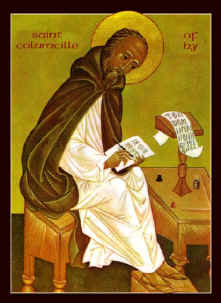Columba of Iona
d. 9 June 597
 Also known as
Colum ("dove") or Columcille ("dove of the churches"), Columba is
called the Apostle of Caledonia (Scotland). Something is known of Columba's life from
the writings of the early historians Bede and Adamnan. He was born in Tyrconnell,
Hibernia (now Garten, County Donegal, Ireland), around 521. Both his parents were of royal
blood, his father being of the Clan O'Donnell, the family of several rulers in
Ireland and western Scotland. As was the custom among the upper classes of that time, he
was sent at a very young age to study in monasteries, first with Saint Finnian of
Moville, by whom he was ordained deacon, and later under Saint Finnian of Clonard.
Also known as
Colum ("dove") or Columcille ("dove of the churches"), Columba is
called the Apostle of Caledonia (Scotland). Something is known of Columba's life from
the writings of the early historians Bede and Adamnan. He was born in Tyrconnell,
Hibernia (now Garten, County Donegal, Ireland), around 521. Both his parents were of royal
blood, his father being of the Clan O'Donnell, the family of several rulers in
Ireland and western Scotland. As was the custom among the upper classes of that time, he
was sent at a very young age to study in monasteries, first with Saint Finnian of
Moville, by whom he was ordained deacon, and later under Saint Finnian of Clonard.
He chose to remain in the monastic life, and as a young man went on several missionary journeys and founded two new successful monasteries, Daire Calgaich at Derry (now Londonderry) in 546 and Dair-magh at Durrow in County Offaly in 551. He was ordained to the priesthood in 551. He functioned in the two monasteries for twelve years, and then in 563, at the age of 42, he journeyed to Britain with 12 followers (later known as the Twelve Apostles of Britain). In a storm his boat nearly foundered and was blown to the island of Iona off the west coast of Scotland. Believing that God had intentionally placed him there, he took possession of the deserted island and founded a monastery dedicated to missionary work among the pagans.
He and his followers went into Scotland to the area in the Highlands beyond the Grampian mountains with the intent of bringing the gospel to the fierce Pictish tribes there. Surprisingly, he was warmly received by the barbarian Picts. Columba's efforts were highly successful, establishing mission stations throughout the Highlands, the Hebrides, and the Orkneys. The mother house at Iona retained control over all the monasteries and mission stations built by Columba and his followers, and for centuries remained the primary link between the Irish and Scottish churches.
In the troubled and violent Dark Ages in Northern Europe, monasteries served as inns, orphanages, centres of learning, and even as fortresses. The light of civilization flickered dimly and might have gone out altogether if it had not been for these convent-shelters.
He spent 34 years organizing and expanding the Church in Scotland, establishing it so firmly that Scotland has been a Christian nation ever since. Columba, already revered as a saint during the last year of his life, died peacefully at Iona in 597. He was working on a commentary on the Psalter one Sunday evening, when he took a little time to rest. He was found the next morning dead before the altar, with a smile on his face. The historian Saint Adamnan, ninth Abbot of Iona, reports him as writing, "This day is called in the sacred Scriptures a day of rest, and truly to me it will be such, for it is the last day of my life and I shall enter into rest after the fatigues of my labours."
The historian Bede tells us that Columba led many to Christianity by his "preaching and example." He was much admired for his physical as well as spiritual prowess. He was a strict ascetic and remained physically vigorous and unflagging in his missionary and pastoral journeys throughout his seventy-six years of life. The memory of Columba lives on in Scotland, and Iona, though desecrated during the Reformation, today houses a flourishing ecumenical religious community.
Acknowledgements:
Text adapted from James Kiefer's Christian Biographies,
Saints and Commemorations (no longer active)
Image from Celtic Orthodox Christianity